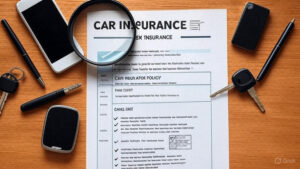5 Essential Steps for a Stress-Free Car Insurance Claim
Let’s be honest—the experience of filing a car insurance claim can be a mixed bag. For some, it’s a smooth process, but for many, it becomes a hectic and confusing ordeal.
Fortunately, a little preparation and knowledge can make all the difference. By following a few key steps immediately after an incident, you can ensure your claim process is as seamless and successful as possible. Here are five essential tips to turn a potentially negative experience into a manageable one.
1. Your Smartphone is Your Best Witness: Document Everything on the Spot

Before you even think about moving your car (unless it’s causing a major hazard), take out your phone. This is the single most crucial step in building a strong claim.
- Take Photos: Capture the scene from multiple angles. Get wide shots showing the position of your car and any other vehicles or objects involved. Then, take close-up pictures of all the damage on your vehicle, no matter how minor it seems.
- Make a Video: A short video can provide context that photos can’t. Do a slow walk-around of your car, showing how it’s positioned relative to a wall, another car, or a truck it may have collided with.
This visual evidence is invaluable. It provides undeniable proof to the insurance surveyor that the damages you are claiming are genuine and directly resulted from this specific incident.
2. Time is of the Essence: Notify Your Insurer ASAP
Don’t delay. The moment you are safe and have documented the scene, your next call should be to your insurance company to report the claim. “Intimation” is simply the official process of informing them that an accident has occurred.
You can usually do this in several ways:
- Call their 24/7 toll-free claims hotline.
- Contact your insurance agent directly.
- Visit the nearest branch office.
All the necessary contact information, including your policy number and the helpline number, is printed on your insurance policy document. Prompt intimation gets the process started quickly and shows that you are acting in good faith.
3. Honesty is the Best Policy (Literally)
It can be tempting to listen to advice from workshops or friends suggesting you add old dents or exaggerate the accident details to get more coverage. Avoid this at all costs.
Surveyors are highly trained professionals who can easily distinguish between new and old damage. They can tell if the story you’ve written on the claim form doesn’t match the physical evidence. Lying or providing false information is known as misrepresentation of a material fact, and it can have serious consequences. At best, it creates suspicion and delays; at worst, your entire claim can be legally rejected, leaving you to pay for everything out of pocket. Always describe the incident exactly as it happened.
4. Scrutinise the Workshop’s Estimate Before Submission

When you take your car to the workshop, they will prepare an initial estimate of the repair costs. Many people simply sign off on this and let the workshop handle the rest. This is a mistake.
Firstly, sit down and review it carefully. Ensure that every single visible damage—every dented panel, broken light, or scratched bumper—is listed.
- Why is this important? Insurance companies are often reluctant to approve damages that weren’t included in the initial estimate.
- What about internal damage? It’s understood that some damage isn’t visible until the car is opened up. These can be added later through a supplementary estimate, which is usually approved if the internal damages are consistent with the accident’s nature.
By checking the initial list, you ensure all the obvious damages are on record from the very beginning.
5. Read Before You Need: Understand Your Coverage

The biggest source of disappointment during a claim comes from a simple misunderstanding of the policy. Many people assume “full coverage” means they will pay nothing, only to be surprised by deductions for depreciation, consumables, and other costs when the final bill arrives.
Before you even need to file a claim (ideally, when you buy the policy), take the time to read it. Understand what’s included:
- What is your base coverage?
- What add-ons do you have? Have you opted for popular riders like Zero Depreciation, Engine Protection, or Consumables Cover?
Read Also: From Crash to Cash: 5 Tips for a Hassle-Free Car Insurance Claim
Knowing your policy’s inclusions and limitations will set realistic expectations. It prevents the shock of unexpected expenses and allows you to discuss your claim with the surveyor and workshop from an informed position. Understanding your add-ons is particularly important, as they can save you a significant amount of money.
By keeping these five points in mind, you can take control of the claims process and ensure your experience is fair, transparent, and efficient.

Sajid Ahmad is an auto enthusiast and passionate blogger who loves exploring the world of cars, bikes, and emerging automobile technologies. With a deep interest in how vehicles shape everyday life, he shares insightful reviews, tips, and updates from the auto industry. Through his blog, Sajid aims to make it easier for readers to stay informed and choose the right ride for their needs

